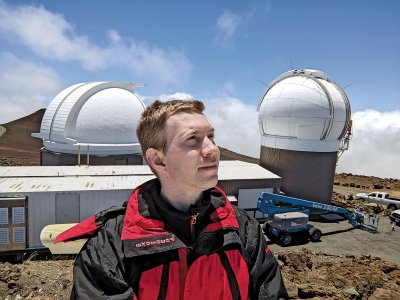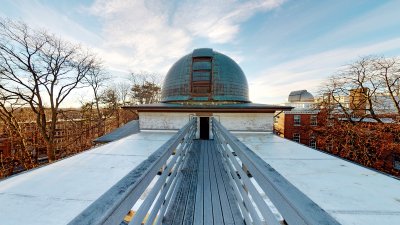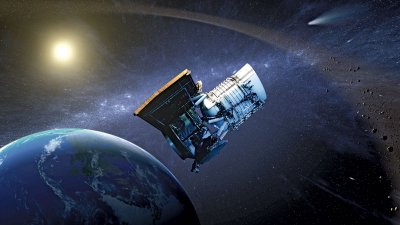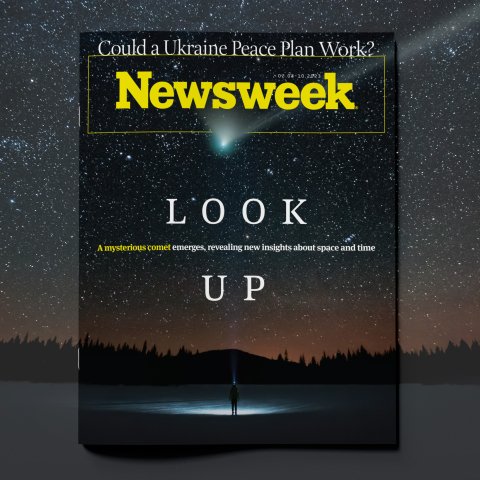The new comet that's appeared in the night sky between the Big and Little Dippers is no visual extravaganza. To the unaided eye, it's just a small, green-tinged blob—nothing like Halley's Comet of 1910, whose tail stretched two-thirds of the way across the sky. And it will pass quickly, fading from view a week or two after reaching peak brightness in early February—a far cry from, say, Hale-Bopp's recording-breaking 15 months in the sky in 1997.
This comet, though, differs from the others in one important respect: it has traveled a much greater distance to get here. Although scientists are still trying to pin down details of where it came from and where it's headed, they reckon it takes 50,000 years to complete a round trip. (Hale-Bopp takes about 2500 years, Halley a mere 76.) That places its origin at the edge of the solar system, on the brink of interstellar space.

This region, known as the Oort Cloud, may extend halfway to the nearest star, Proxima Centauri—the distance light travels in two years, more than 10 trillion miles. The Oort Cloud dates back 4 billion years, when a cloud of gas and dust collapsed upon itself to form the sun and the planets. At the extreme outer edge, where the sun's gravity is weak, bits of this primordial material were left behind, like crumbs.
"Those little pieces, which could be the size of mountains, become the comets that we know today," says Amy Mainzer, an astronomer at the University of Arizona. "We're so interested in these objects because we know things like this particular comet have to be very old, extremely old."
The last time this comet visited our cosmic neighborhood, Neanderthals, our low-browed human cousins, still walked the Earth. It's possible that they, along with our modern human ancestors, paused from their hunting and gathering to wonder why this smudge of light appeared seemingly out of nowhere and then mysteriously disappeared a few weeks later.
It took another 40,000-plus years for civilization to put a telescope in the hands of Galileo, who used it, a mere 413 years ago, to prove that the Earth is round and that the sun, moon and stars do not revolve around it. His insight laid the foundation for understanding this transient point of light for what it truly is: a visitor from the darkness of vast distances and time.
Today's earthly observers are better prepared than our ancestors were. The planet bristles with telescopes pointed to the skies, and a few more look up from low-earth orbit. In recent years, NASA has spent millions specifically to beef up observations of so-called near-earth objects—comets and asteroids—the better to warn of potentially dangerous objects coming toward us at great speed. This investment is also yielding more observations and some good science.
That the comet will be visible to all, though, transcends science and self-defense. "Whenever you can see one of these objects for your own self, it is a powerful reminder that we are in a living cosmos," says Mainzer. "A living universe. Not static."


The Discovery
The Zwicky Transient Facility at Mt. Palomar in California is basically a camera attached to a telescope. Every night, it scans the heavens for signs of movement. Scientist Frank Masci of CalTech, a co-discoverer of the new comet, designed artificial-intelligence software to sift through digital images and pick out which points of light cannot be accounted for in the database of known celestial objects and alert scientists.
This particular comet was found in a survey of the sky just before dawn and just after dusk, says Tom Prince, co-director of ZTF. "In these dawn-dusk surveys, we take five or so images at different times of the same star field. Then we look to see if there is an object that moves from image to image." On the morning of March 2, Bryce Bolin, an astronomer from NASA who was working at the time at Zwicky, looked at the previous night's survey data and identified a moving point of light.
The scientists at Zwicky initially thought they had found an asteroid. The camera image showed a point of light, which is what asteroids look like, mainly because their long exposure to the sun's harsh rays tends to have long ago burned off any ice, gas or other "volatiles," leaving a hard surface of rock that reflects light sharply.
"We saw it was moving and we were pretty sure it was real," says Quanzhi Ye, an astronomer at Zwicky. "But it wasn't fuzzy, it was basically a dot."
They didn't fret much over whether they were right or wrong. Their sighting was only the first step in the process by which a comet, asteroid, planet, star or any other celestial object takes its place in the pantheon. They gave it a name—asteroid ZTF0Nf7—noted its position and trajectory and passed it along to the Minor Planet Center in Cambridge, Massachusetts, a clearinghouse of astronomical observations from around the world. The Center's dozen or so scientists collect data on tens of thousands of sightings each year, from the big NASA space telescopes and everything on down to the backyard scopes of amateurs. All told, the Center, which has been in operation since 1947, has helped identify about 4,000 comets and 1.25 million asteroids.
The Minor Planet Center posted details of the sighting on its website, so the loose community of professional and amateur astronomers could get to work, making their own observations and contributing their data. The goal was to refine estimates of the orbital path and other details. "It's not good enough to just see a comet or an asteroid," says staff astronomer Peter Veres. "We have to determine their orbits, and that takes multiple observations."
The most important confirmation came from an amateur astronomer from Tokyo, H. Sato, who noted the fuzzy appearance of ZTF0Nf7—the telltale sign of a comet.
Whereas asteroids tend to live in the inner solar system, jostling with one another and with the planets "like a bag of marbles," as Mainzer puts it, comets are pristine objects. this comet probably formed billions of years ago, and for a while peacefully kept a great distance from the sun in a long, loping circular orbit. At some point, something disturbed it—perhaps the gravitational tug of another comet-like object passing close by, or something else entirely that had drifted over from another part of the galaxy. Whatever it was, it tipped the comet off course and sent it careening in toward the sun.
As the comet gets closer, the sun's rays vaporize its ice and ionize its gases, creating a kind of glowing mist around it, called a coma, and a tail of gas and dust. (The greenish hue comes from molecules of carbon and nitrogen being ionized as it approaches the sun.) Sato's observation was quickly confirmed by other astronomers from Italy, Brazil and elsewhere. A few weeks after the initial discovery, Veres and his staff declared ZTF0Nf7 to be a comet and, along with established norms, named it C/2022 E3 ZTF, after its discoverers, the staff of Zwicky.



Celestial Timepiece
The 50,000-year period of Comet ZTF is, depending on your point of view, a very long time or a very short time. In the cosmos, not much has changed since the time of the Neanderthals, and not much will change between now and the comet's return. The universe is 14 billion years old. Life began on Earth 3.7 billion years ago. Our sun is expected to run out of hydrogen fuel in 5 billion years and turn into a red giant, devouring the Earth. From this perspective, 50,000 years is but one tick of the celestial clock.
From our corner of the galaxy, however, there will be some noticeable changes. Since the stars that make up the Big Dipper are relatively near—a mere 100 light years away—they will have drifted, changing the constellation beyond recognition. Earth's rotation will have slowed, adding one second to each day. Niagara Falls will have eroded into a meandering waterway. Glaciers will have returned to the Northern Hemisphere, unless greenhouse gas emissions interfere.
About the same time Comet ZTF last came round, a 50-meter-wide meteorite struck what is now Meteor Crater, Arizona, blasting a hole 4000 feet wide and 600 feet deep. (It's still there, but you need to buy tickets to see it.) The odds that something like that will happen again anytime soon are small, but not zero. This is another reason scientists are interested in this comet, and comets in general.
"Long-period comets tend to be very big and move very fast compared to objects in the inner solar system, like asteroids. So even though they're relatively rare, they have the potential to pack a big punch," says Mainzer. "And it's hard to see them until they're relatively close."
Finding comets and asteroids, and studying their orbits in detail, is key to forecasting a collision. "Asteroids don't just head straight for Earth," says Kelly Fast, NASA's coordinator for planetary defense. "It's more like rush-hour around the Capitol building [in Washington, D.C.]. Everything is going around and around and then at some point two things come to occupy the same space, and you have a collision."
In September, NASA's DART spacecraft struck the asteroid Dimorphos with a projectile, demonstrating the feasibility of deflecting an asteroid or comet, should it ever be necessary. The mission brought home the need to intervene early, while the object is far enough away for an impact to significantly change its trajectory. If Comet ZTF were headed toward Earth, its discovery in March would have been too late to do much about it. (To be clear, it is not headed toward Earth.) This need to act early adds some urgency to efforts to observe and catalog comets and asteroids.
In 1995, Congress charged NASA with identifying 90 percent of all asteroids, comets and other near-earth objects bigger than one kilometer in diameter. That's big enough to cause a global catastrophe much like the one that extinguished the dinosaurs 65 million years ago. In 2005, the mandate changed to objects larger than 140 meters, which are big enough to cause large-scale regional disruptions. In 1908, a meteorite thought to be about 40-meters wide flattened 820-square-miles of Siberian forest. (An asteroid or comet becomes a meteorite when it enters the atmosphere). Ten years ago, a 20-meter wide meteorite blew out apartment windows in Chelyabinsk, Russia, as captured in cell phone videos and dashcams.
NASA has ramped up funding for planetary defense in recent years—Congress appropriated $197 million in 2022, including grants for surveys at Zwicky and other observatories around the world. As a result, says Veres, "the number of new observations has increased exponentially."
NASA's budget also includes the DART mission and a new orbiting telescope, the Near-Earth Object Surveyor Mission It will replace an aging orbiting telescope that was repurposed from a previous mission and is now long past its prime. By
contrast, the NEO Surveyor, slated for launch by 2028, is designed specifically for hunting asteroids and comets. It will hover, in gravitational equilibrium, between Earth and sun, where it can better view parts of the sky now hidden by the sun's glare.
"What we'd really like to be able to do is not just see further away, but also be able to peer down into the daytime sky and monitor those regions around the sun, because stuff can be back there just as well as it can be in the night side," says Mainzer, who is the mission's principal investigator.
With all the attention to celestial threats, Mainzer sounds a note of calm. The odds of a big asteroid strike are low, and even lower for comets. "This isn't something that should keep people up at night," she says. "It's a very rare occurrence. If it truly was frequent, human beings probably wouldn't be living on planet Earth because we would've been wiped out by successive impacts."



The Next 50,000 Years
Scientists are still working out the details of Comet ZTF, including its precise orbit, gathering data and refining predictions. Like many long-period comets, this one is perpetually on the verge of going "hyperbolic"—assuming an orbit that takes it out of the solar system entirely and into the vast emptiness of interstellar space, where it would drift to some distant star or, eventually, out of the Milky Way galaxy entirely.
"We've seen other [long-period] comets pass through the inner solar system, and the major planets give it a gravitational kick right out of the solar system," says Quanzhi Ye.
So far, he doesn't expect that to happen. In a few weeks the comet will pass the big planets—Jupiter, Saturn and Neptune—whose gravitational pull should keep it in an elliptical orbit that brings it back to our cosmic neighborhood in 50,000 years or so. (Fingers crossed.)
Will anyone be here to see it? Considering our species' current trajectory, 50,000 years seems ambitious. Between now and then, we will have to solve some big problems, like how to fix our climate, feed 10 billion people and stay one step ahead of ChatGPT.
If we're lucky, our descendants may be watching from Mars, "terraformed" into a new Earth-like home, with air and a rich soil for growing food. Human colonies may be halfway through an intergenerational voyage to a neighboring star.
And what will 50,000 years of evolution have turned us into? Perhaps weird, space-dwelling creatures, with skin that protects us from radiation and the vacuum of outer space and fins that absorb energy directly from the sun. Or maybe we'll have transfered our minds to machines and merged into a meta-intelligence that spreads out among the stars.
Such thoughts are a hazard of comet gazing. Pass the binoculars.
Correction (1/25/2023, 12:28 pm): This article previously identified Peter Veres erroneously as a director of the Minor Planet Center. He is an astronomer on staff.
Clarification (1/27/2023, 11 am): This article was modified to mention Bryce Bolin's role in the discovery of the comet.















